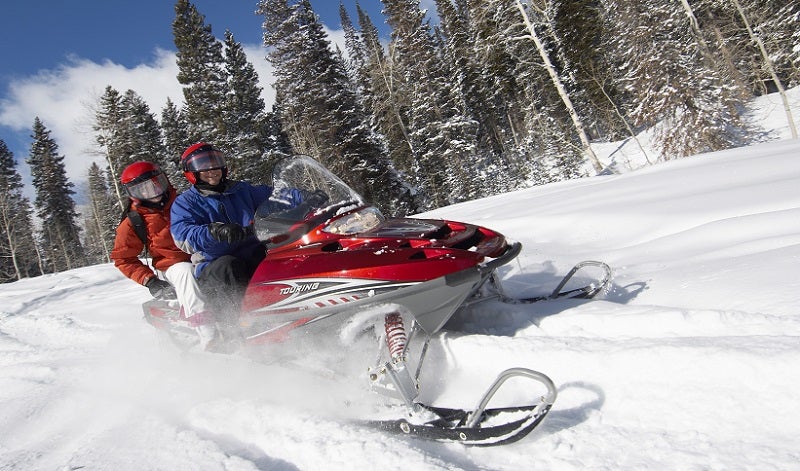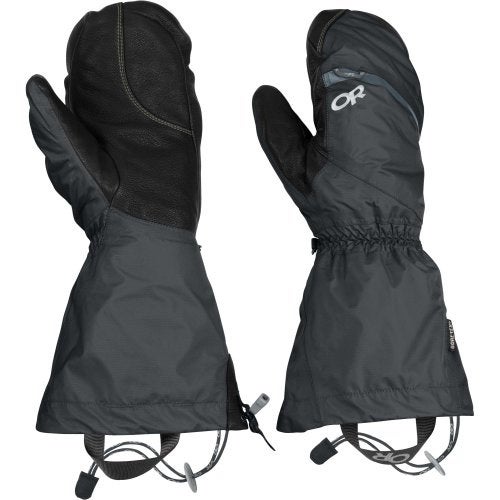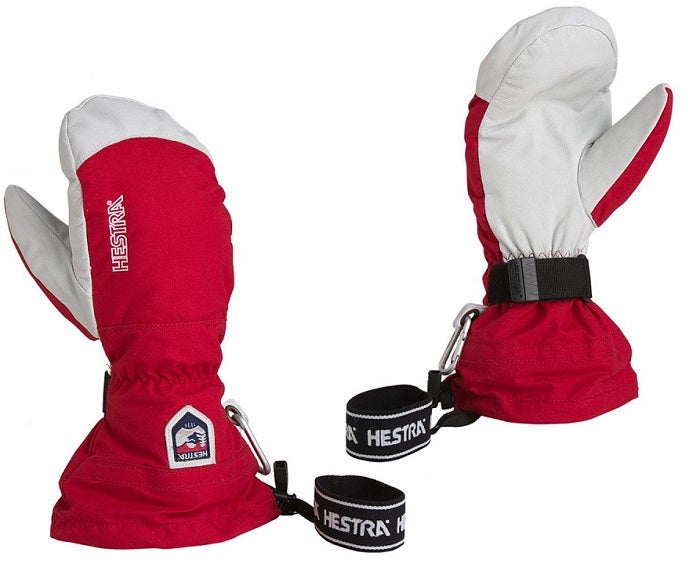
Our Editors independently research, test, and rate what we feel are the best products. We use affiliate links and may receive a small commission on purchases.
Whether you’re heading out on a sled (or snowmobile) for the first time, or if you’re a seasoned pro, there are always new solutions on the market.
With wind, water and snow whipping by in the nasty conditions while you’re snowmobiling, you’ll need the best gloves that can keep up the pace with your sled. It’s just not going to cut it to buy something cheap that likely won’t last very long.
I’m going to help you navigate the hassle of identifying the best glove qualities, materials, and design for your next snowmobile trip and we’ll narrow it down to what really works.
With so many options on the market you’ll be glad you stopped by to learn what’s working and what’s not. Let’s get to it.
Best Snowmobile Gloves
For more of my snowmobile gear recommendations, have a look through these popular Outside Pursuits guide links: Snowmobile Helmets, Snowmobile Goggles, Snowmobile Boots
Quick Answer: The 5 Best Rated Snowmobile Gloves
- KILM Togwotee GORE-TEX Snowmobiling Gloves
- Savior Electric Heated Gloves
- Outdoor Research Alti Mitts
- Hestra Army Leather Heli Ski and Cold Weather Mitt
- FXR Snow Fuel Snowmobile Gloves
Our reviews of the top rated snowmobile gloves with our buyers guide will help you choose the right pair for you.
Snowmobile Gloves Reviews
#1 KLIM Togwotee GORE-TEX Snowmobiling Glove
When it comes to snowmobiling Klim is among the best brands you will find and our Editors Choice for the best snowmobiling gloves. To start off, they have Gore-Tex to keep your hands dry while allowing sweat to evaporate.
They have 200G of 3M Thinsulate Insulation on the top of glove with another 100G on the palms, enough to keep your hands toasty when the needle drops below zero.
One feature I especially like is the palms have a tacky non-slip grip to help maintain control of the sled. Being a gauntlet style glove, they seal up against your jacket and cinch closed to keep the cold out.
I really never use them, but they also feature goggle squeegies, so these are there if you want them! All in all, these are a good pair of snowmobiling gloves that will keep your hands warm.
#2 Savior Electric Heated Gloves
Heated and rechargeable gloves are becoming more popular as the tiny batteries needed to make them feasible become more efficient. There are several different models available but this one, from Savior, features waterproof breathable construction.
On top of a great weatherproof outer shell, a good battery powered glove needs to last a while. These will run 7 hours at a time and can be charged using the included double wall charger.
With two settings, you’ll be able to adjust them for the quick trip into town, or the long afternoon snowmobile tour down the lake. If you are looking for cold weather snowmobile gloves, these are it!
You can always combine this glove with a liner or vapor barrier to triple the effectiveness in the harshest climates.
#3 Outdoor Research Alti Mitts
For a standard mitt, you’ll be hard pressed to beat the quality of Outdoor Research. OR headwear and gloves have been a standard go-to choice for me for years.
Their styling and quality is second to none and you’ll love these waterproof / windproof snowmobile mittens.
When the weather turns wet and the wind is ripping by on the sled, you’re going to want to breathe easy knowing your gloves can handle the challenge.
Video: Overview of the Outdoor Research Alti Mitts.
These are gore-tex snowmobile gloves with with an updated construction method that make these gloves more protective and limber than ever.
Best part?
They have removable liners for fast drying and adjustable cuffs. Pull the mitts over your jacket and cinch down the elastic wrists to lock out the cold and snow.
#4 Hestra Army Leather Heli Ski Mitt
My personal skiing mittens are Hestra made and I must say – they’re about the best in the industry. Though they’re not waterproof, they’ll serve you perfectly in any condition but rain.
Without a doubt, the removable liner is a critical element for any great mitt. Why? Because you can quickly pull out the liner when you get to the bar or your family’s house and toss it on the heater to dry.
Once the liner is dry in an hour you’ll be ready to hop back on the sled and tackle the cold weather.
These are made from 70% goat leather which is known for being tough and supple at the same time. I think these are the best leather snowmobile gloves you can buy.
Taking off on a longer snowmobile trip? I’d recommend buying two sizes larger and wearing a thin liner inside your Hestra mitts for ultimate warmth. Pair that with a set of nitrile exam gloves for a vapor barrier and there’s no way you’ll be chilly!
#5 FXR Heated Recon Snowmobile Gloves
FXR is one of the best known brands in snowmobiles so you can trust they know how to make a pair of gloves. Were looking at gloves that have 500 total grams of Thinsulate insulation throughout the gloves for warmth when you’re out riding on those chilly days.
On top of that, these are heated gloves with up to 5 hours of heat on the lower setting. The shell of the gloves are water resistant along with a breathable Hipora membrane liner to keep you hands dry and comfortable.
I like the articulated (pre-curved) fingers, they make a difference when gripping the handlebars for hours.
Little extras like a goggle wipe on the thumb and an adjustable cuff to keep the snow and cold out make these gloves a solid contender.
#6 Icebreaker Glove Liner Handwear
Here’s the solution to any liner glove need. Thin, stretchy merino wool liner gloves are fast drying, wicking and skin tight.
Why are these important qualities? You’ll want a skin-tight fit on your liner gloves for snowmobiling to retain dexterity and control of the sled. It also leaves ample room to fit inside most gloves – especially if you size up on your main pair of gloves.
Merino wool is one of the best next-to-skin fabric choices for cold weather as it’s extremely warm, odor resistant, and has some of the best moisture-wicking properties of any fibers on the market today.
It even exceeds polyester in its ability to wick away moisture, which keeps the skin warm and dry.
This is the perfect solution for a little extra layer of warmth and dexterity when you need to take off the outer glove or mitten.
#7 VersaPro Nitrile Exam Gloves
Many people think I’m joking about using exam gloves to increase the warmth and protection of your snowmobiling gloves or mittens?
Think again.
By keeping our sweat from soaking in to our liner gloves or our main gloves and mittens, we can significantly increase the effectiveness of our gloves. It’s dirt cheap to pick up a few pairs of nitrile exam gloves and they’ll last for ages.
Take them on your next trip and share a pair with your buddies when they start whining about cold hands. You’ll be the hero.
A little pro tip for the trail: save your gloves and reuse them a few times. They’re more durable than you might think and a single glove will probably last half a dozen trips if you’re gentle with them.
Snowmobile Glove Comparison Table
| Snowmobile Gloves | Shell | Insulation | Heated | Removable Lining | |
|---|---|---|---|---|---|
| KLIM Togwotee GORE-TEX Snowmobiling Gloves | Nylon | 200g on top, 100g in palm | No | No | |
| Savior Electric Heated Gloves | Nylon / Leather | 100g fleece | Yes: 7 hrs | No | |
| Outdoor Research Alti Mitts | 40D Ripstop Nylon | 170g in shell, 340g in liner | No | Yes | |
| Hestra Army Leather Heli Mitt | Goat Leather, polyamide | Fiberfill | No | Yes | |
| FXR Heated Recon Snowmobile Gloves | Nylon / Leather | 300g on top, 200g in palm | Yes: 5 hrs | No | |
| Icebreaker Glove Liner Handwear | Merino wool / Elastane | N/A | No | No | |
| VersaPro Nitrile Exam Gloves | Thick Nitrile | N/A | No | No |
How to Choose the Best Snowmobile Gloves
- Waterproof Materials
- Liner Gloves
- Glove or Mitten?
- Vapor Barrier
- FAQs About Snowmobile Gloves
- Conclusion

There are tons of criteria for picking out the right gloves. Which materials get the job done the best? Which waterproof fabric is the winner today? We’ll take a look at what makes a great snowmobile glove:
Waterproof Materials
There was a time when Gore-Tex reigned as the only name in waterproof breathable fabrics. Today, Gore-Tex’s patent has expired and just about every fabric maker has their own waterproof breathable fabric. Some of these waterproof breathable fabrics are actually better at their job than Gore-Tex. One example is eVent. This fabric is much more breathable and just as waterproof as Gore-Tex. If you can find an eVent fabric glove – go for it! These are great options.
Is breathable really necessary? It’s arguable. I don’t personally put much stock in breathable fabrics. My experience has been that they’ll get wet from sweat no matter what you do, in most conditions.
Liner Gloves
Many people choose to use a two-glove system. This is a type of layering for gloves which involves one thin liner glove inside of a thicker waterproof and warm shell glove or mitten. I personally prefer this method over a single glove solution. Because liner gloves allow you to remove your hand and do things like easily buckle a helmet or zip a zipper without removing your gloves entirely. They’re also easier to wash and dry than a full glove once they’re wet or sweaty.
Glove or Mitten?
This can be personal preference but, as a rule, I recommend mittens. Unless you need the fumbling dexterity of large gloves, mittens are a better option. Why? Because keeping all your fingers inside a single pocket helps to insulate much better than individual fingers. For most situations, mittens will be warmer than the equivalent glove and I recommend their use.
Vapor Barrier
Vapor barrier liners are a simple concept but often overlooked. In theory, a vapor barrier simply is an occlusive liner between your skin and your clothing. This keeps sweat from collection on your insulated clothing. Once your clothing becomes wet from sweat, the insulation value begins to rapidly drop. For this reason, some people choose to use vapor barriers.
A simple solution to this issue is a plan-old nitrile glove. Many skiers and outdoor professionals use a laboratory glove such as a nitrile exam glove under their main glove to help prevent the buildup of sweat on the glove. This is a particularly effective solution and you’ll be amazed at how well it actually works!
FAQs About Snowmobile Gloves
Q: If you had to pick, what kind of glove would you take with you?
A: First of all, it doesn’t take much convincing to get me on a snowmobile. I love riding (when there’s enough snow around here)! When it’s time to get out there, however, I don’t skimp on gloves. I hate cold hands. For a snowmobile ride, I would opt for full mitts. If the weather is warmer, wet or maybe rainy, then I’ll go with waterproof mitts. For cold temperatures where there’s little chance of getting wet, I always go with non-waterproof gloves. Good old leather palm mitts over the top of some nice liner gloves are the ticket to success for me. I always look for nice tall cuffs, too, so they can come up over my snowmobiling jacket and cinch down.
Q: What kind of maintenance is ideal for snowmobile gloves?
A: Optimally you should be taking care of your gloves after each ride or at least once a season for you heathens who just leave your gear lying around (I’m guilty as charged)!
There’s one post-ride task that should never be skipped, however. The most important thing you can do to get the most out of your gloves is to dry them after every ride. Even a little bit of sweat or moisture left in your gloves will make them feel extra cold the next time you go on a ride. Toss your gloves in the dryer or leave them on a heat vent overnight and they should be good to go!
Additionally, for waterproof breathable gloves, you should give them a treatment of wash-in DWR once a season or every other season. Once that DWR coating wears off the outer layer and the gloves “wet out” they then lose their breathability. For gloves with leather, consider a seasonal application of Sno-Seal (to the leather only).
Q: Are heated gloves worth the money?
A: Honestly, this depends on how big your budget is, I think.
Assuming that you aren’t on a tight budget I think heated gloves are worth the money for most people. It’s hard to keep your hands warm on a snowmobile because you’re usually not moving much and the cold air just gets your fingers chilly no matter what, it seems. Instead of fighting against those cold fingers, you can charge up your gloves overnight and have a few hours of warm finger riding each day. If you’re riding a lot, consider just turning the gloves on only once your fingers start to get cold to conserve battery. Some heated gloves actually plug into the snowmobile (motorcycles have these too!) and these you won’t have to worry about running out of juice.
Q: How much insulation should my gloves have?
A: For snowmobiling, I don’t think you can have too much, honestly!
If it were a sport where you’re up moving, running, or skiing and spending energy a heavy glove might get too hot. Most of the time on a snowmobile you’re sitting still and the wind is just ripping into the heat of your gloves. One thing I will recommend is that if you go with heavy insulated gloves, still make sure they’re big enough to leave room for a liner glove. Even well-insulated gloves can get cold if they get wet and liner gloves help manage the moisture from your hands inside the gloves.
Q: What are handwarmer pockets?
A: If you don’t have (or don’t want) electrically heated gloves, you can go with the chemistry analog.
Handwarmers are those little packets that you shake to activate and they slowly warm up to release heat all day long. They can usually stay warm for about 6-8 hours at a time and they’re pretty cheap compared to electronic gloves. Gloves lacking hand warmers force you to stuff the little packet into the glove alongside your hands. This is problematic for two reasons. First, the packets can get dangerously hot when placed next to the skin. Second, the packets get in the way of dexterity. Handwarmer pockets are great because they store the little packet on the back of your hand. It’s out of the way for handling objects, it’s not directly next to skin, and it won’t fall out of the glove if you take the glove off.
Conclusion
For some serious firepower on your next snowmobiling trip try this: use a pair of disposable nitrile gloves and wear some thin liner gloves over the top of them. Then, toss a pair of heated gloves over all of that and head off on the trail. You’ll be blown away at how warm your hands stay. Of course, in most situations you’ll probably overheat with that approach. For most days on the sled, you’ll be well off with a great pair of waterproof and windproof mitts for maximum warmth.
Keep some liner gloves in your pocket in case it gets really cold and toss some nitrile gloves in the saddle bag for extreme weather. Nothing can hold you back with the right equipment.


